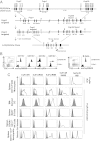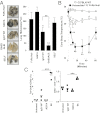Mouse model recapitulating human Fcγ receptor structural and functional diversity
- PMID: 22474370
- PMCID: PMC3341029
- DOI: 10.1073/pnas.1203954109
Mouse model recapitulating human Fcγ receptor structural and functional diversity
Abstract
The in vivo biological activities of IgG antibodies result from their bifunctional nature, in which antigen recognition by the Fab is coupled to the effector and immunomodulatory diversity found in the Fc domain. This diversity, resulting from both amino acid and glycan heterogeneity, is translated into cellular responses through Fcγ receptors (FcγRs), a structurally and functionally diverse family of cell surface receptors found throughout the immune system. Although many of the overall features of this system are maintained throughout mammalian evolution, species diversity has precluded direct analysis of human antibodies in animal species, and, thus, detailed investigations into the unique features of the human IgG antibodies and their FcγRs have been limited. We now report the development of a mouse model in which all murine FcγRs have been deleted and human FcγRs, encoded as transgenes, have been inserted into the mouse genome resulting in recapitulation of the unique profile of human FcγR expression. These human FcγRs are shown to function to mediate the immunomodulatory, inflammatory, and cytotoxic activities of human IgG antibodies and Fc engineered variants and provide a platform for the detailed mechanistic analysis of therapeutic and pathogenic IgG antibodies.
Conflict of interest statement
The authors declare no conflict of interest.
Figures




Similar articles
-
N-linked glycan structures of the human Fcγ receptors produced in NS0 cells.J Proteome Res. 2013 Aug 2;12(8):3721-37. doi: 10.1021/pr400344h. Epub 2013 Jul 11. J Proteome Res. 2013. PMID: 23777450
-
Development and Characterization of Monoclonal Antibodies Specific for Mouse and Human Fcγ Receptors.J Immunol. 2015 Dec 1;195(11):5503-16. doi: 10.4049/jimmunol.1402988. Epub 2015 Oct 28. J Immunol. 2015. PMID: 26512139
-
Fcγ receptor pathways during active and passive immunization.Immunol Rev. 2015 Nov;268(1):88-103. doi: 10.1111/imr.12343. Immunol Rev. 2015. PMID: 26497515 Free PMC article. Review.
-
Multi-Angle Effector Function Analysis of Human Monoclonal IgG Glycovariants.PLoS One. 2015 Dec 11;10(12):e0143520. doi: 10.1371/journal.pone.0143520. eCollection 2015. PLoS One. 2015. PMID: 26657484 Free PMC article.
-
IgG Fc Receptors: Evolutionary Considerations.Curr Top Microbiol Immunol. 2019;423:1-11. doi: 10.1007/82_2019_149. Curr Top Microbiol Immunol. 2019. PMID: 30739161 Review.
Cited by
-
A Fc engineering approach to define functional humoral correlates of immunity against Ebola virus.Immunity. 2021 Apr 13;54(4):815-828.e5. doi: 10.1016/j.immuni.2021.03.009. Immunity. 2021. PMID: 33852832 Free PMC article.
-
Enhancement of Antibody-Dependent Cellular Cytotoxicity and Phagocytosis in Anti-HIV-1 Human-Bovine Chimeric Broadly Neutralizing Antibodies.J Virol. 2021 Jun 10;95(13):e0021921. doi: 10.1128/JVI.00219-21. Epub 2021 Jun 10. J Virol. 2021. PMID: 33853957 Free PMC article.
-
The role of IgG Fc receptors in antibody-dependent enhancement.Nat Rev Immunol. 2020 Oct;20(10):633-643. doi: 10.1038/s41577-020-00410-0. Epub 2020 Aug 11. Nat Rev Immunol. 2020. PMID: 32782358 Free PMC article. Review.
-
Enhancement of epidermal growth factor receptor antibody tumor immunotherapy by glutaminyl cyclase inhibition to interfere with CD47/signal regulatory protein alpha interactions.Cancer Sci. 2021 Aug;112(8):3029-3040. doi: 10.1111/cas.14999. Epub 2021 Jun 18. Cancer Sci. 2021. PMID: 34058788 Free PMC article.
-
Distinct and synergistic roles of FcγRIIB deficiency and 129 strain-derived SLAM family proteins in the development of spontaneous germinal centers and autoimmunity.J Autoimmun. 2015 Sep;63:31-46. doi: 10.1016/j.jaut.2015.06.011. Epub 2015 Jul 7. J Autoimmun. 2015. PMID: 26162758 Free PMC article.
References
-
- Nimmerjahn F, Ravetch JV. Fcgamma receptors as regulators of immune responses. Nat Rev Immunol. 2008;8:34–47. - PubMed
-
- Nimmerjahn F, Ravetch JV. Divergent immunoglobulin g subclass activity through selective Fc receptor binding. Science. 2005;310:1510–1512. - PubMed
-
- Cartron G, et al. Therapeutic activity of humanized anti-CD20 monoclonal antibody and polymorphism in IgG Fc receptor FcgammaRIIIa gene. Blood. 2002;99:754–758. - PubMed
-
- Clynes RA, Towers TL, Presta LG, Ravetch JV. Inhibitory Fc receptors modulate in vivo cytotoxicity against tumor targets. Nat Med. 2000;6:443–446. - PubMed
-
- Musolino A, et al. Immunoglobulin G fragment C receptor polymorphisms and clinical efficacy of trastuzumab-based therapy in patients with HER-2/neu-positive metastatic breast cancer. J Clin Oncol. 2008;26:1789–1796. - PubMed
Publication types
MeSH terms
Substances
LinkOut - more resources
Full Text Sources
Other Literature Sources
Molecular Biology Databases

